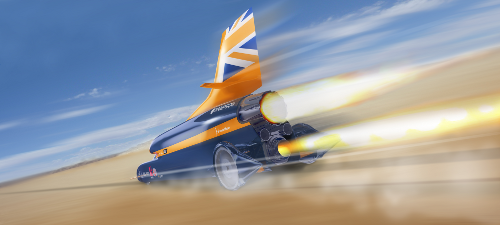The man who hopes to become the first to drive at 1,000 mph has inspected the track where the Bloodhound SuperSonic Car will make the record attempts. Meanwhile project staff are working on the first test of a hybrid rocket engine that will be among three separate engines in the vehicle.
The Bloodhound Project, based in my hometown of Bristol, aims to use the land speed record attempt to educate and inspire interest in science and engineering. It was conceived by Lord Drayson (then the country’s government minister responsible for science) and is headed by Richard Noble and Andy Green.
Noble is an engineer that held the land speed record from 1983 until 1997 until it was twice beaten by a vehicle he helped built, driven by Green. The second drive by graan still holds the record and, at 763 mph, was the first time a land vehicle broke the sound barrier.
The new vehicle uses a combination of three engines. The main one is an 18 inch by 12 foot hybrid rocket that will be the most powerful used in the UK for twenty years. It burns a combination of a solid fuel (hydroxyl-terminated polybutadiene) and nearly a metric ton of a liquid oxidizer (high-test peroxide.)
Somewhat staggeringly, the second engine — adapted from a Formula One racing car — will be used solely to propel the liquid fuel into the main rocket. This combination will produce around half of the thrust used by the vehicle. The rest comes from a more familiar jet engine, adapted from a Eurofighter-Typhoon plane.
Staff will test the three-engine combo for the first time at Newquay Airport on October 3. For this test the rocket will be securely bolted down.
Meanwhile Green has just written for the BBC about his first visit to Hakskeen Pan, a desert area in South Africa. It’ll be the site of the record attempts, chosen partly because it offers flat and consistent surfaces, and partly so that there’s plenty of empty space if the car winds up off course.
The main track is 19 km long (just enough to hit top speed and then come back to a stop) and 500 metres wide (allowing several test runs without ruining the track.) Flat as the area is, it still required the removal of 6,000 metric tons of stone, a job that had to be carried out by hand and created work for 300 local unemployed people.
The goal is to break the record next year, perhaps hitting 850 mph, then to refine the vehicle and hit the 1,000 mph mark in 2014.

